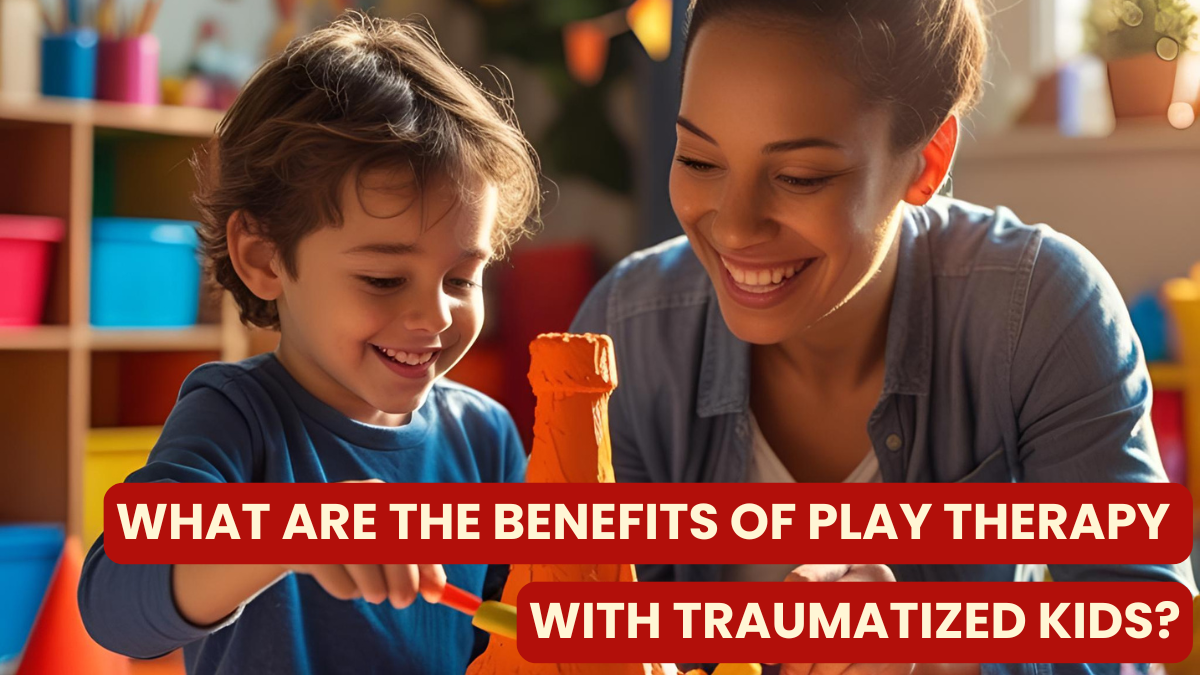What Are the Benefits of Play Therapy with Traumatized Kids?

Play therapy isn’t just about toys or games—it’s grounded in the therapeutic powers of play, a research-based framework that explains why and how play heals. These powers include the ability to foster emotional expression, build relationships, support problem-solving, promote self-regulation, and facilitate trauma processing.
What sets play therapy apart from other expressive arts modalities—like art, music, or drama—is that play is a child’s natural language. While expressive arts often rely on symbolic communication through a specific medium, play therapy uses the child’s existing world of play as both the language and the process for therapeutic change. Play engages the whole child—body, brain, and nervous system—creating a unique opportunity to support growth and healing.
When a child has experienced trauma, play therapy can be a transformative space. Here’s how the therapeutic powers of play directly support healing:
1. Emotional Regulation
Traumatized children often experience dysregulation in their nervous systems. Play therapy offers repeated opportunities for co-regulation and self-regulation through safe, predictable, and attuned interactions in the playroom. Over time, this strengthens the child’s capacity to manage emotions more effectively outside the session.
2. Increased Self-Esteem and Confidence
In play, children take the lead, make choices, and feel seen for who they are. This sense of autonomy and mastery fosters self-confidence. As they experience success and connection through play, children begin to rebuild a positive self-image often damaged by trauma.
3. Reduced Cortisol Levels
Play, especially when attuned and relational, helps reduce cortisol—the stress hormone elevated during trauma. When a child engages in play with a safe adult who mirrors and contains their emotional experience, the brain and body receive the message: you are safe now.
4. Restoring a Sense of Safety
Trauma erodes a child’s basic sense of safety. Play therapy creates a structured, consistent space where the child can explore fears, test boundaries, and re-establish trust in others. The therapist’s presence as a regulated, responsive adult is key to re-patterning the child’s internal working model of safety and attachment.
5. Facilitating Healing
Ultimately, play therapy supports trauma resolution by allowing children to process their experiences in a developmentally appropriate way. They can access painful memories indirectly through metaphor and symbolic play, which often feels safer than verbal processing. Over time, children integrate those experiences, shifting from survival to healing and growth.
Recap: The Healing Power of Play for Traumatized Children
Play therapy offers more than just creative expression—it’s a brain-based, relationship-driven modality grounded in neuroscience and attachment theory. By harnessing the therapeutic powers of play, therapists can support children in:
-
Regulating their emotions and nervous systems
-
Rebuilding self-worth and confidence
-
Lowering stress responses like elevated cortisol
-
Re-establishing safety in relationships and within themselves
-
Processing traumatic experiences in ways that feel safe and developmentally appropriate
Understanding and using these mechanisms with intention is what transforms good therapy into powerful healing work.
Ready to Go Deeper? Join the Course: Healing Trauma Using Play Therapy
If you’re a play therapist ready to move beyond Pinterest activities and step into theory-informed, outcome-driven sessions, this training is for you.
Healing Trauma Using Play Therapy: A Neuroscience and Attachment Approach gives you a clear framework for:
✔ Conceptualizing trauma from a neurobiological lens
✔ Understanding your client’s symptoms through your play therapy model
✔ Selecting interventions based on developmental stage and theory
✔ Helping children move from dysregulation and survival to healing and integration
🎓 Bonus: Enroll before July 12 and receive two free months in the Play Therapy Elevation Circle—a consultation community to help you apply what you learn and grow in confidence.
🔗 Register now at RHPlayTherapyTraining.com and take the next step in transforming trauma through play.
Categories: : Community, Play Therapy, Play Therapy Elevation Circle, Podcast
 Cathi Spooner
Cathi Spooner 
